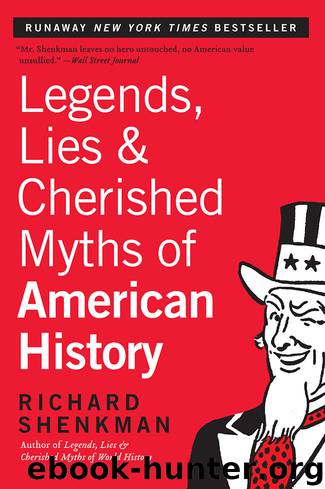Legends, Lies & Cherished Myths of American History by Richard Shenkman

Author:Richard Shenkman
Language: eng
Format: epub
Publisher: HarperCollins
Published: 2012-10-23T16:00:00+00:00
As hostile as anybody were many Americans who themselves were descended from immigrant families. The word “kike,” used to describe the Eastern European Jews, many of whose names ended in ki, was coined by New York’s long-settled German Jews.3
In our own “more civilized” century new immigrants have hardly been treated any better. In the 1910’s those from Southern and Eastern Europe even faced the possibility of mass sterilization—or worse. In a popular book endorsed by Theodore Roosevelt, the racist Madison Grant went so far as to suggest that the state had a moral obligation to put certain immigrant types to death.* In 1924 the federal government, fed up with the influx of Italian, Chinese, and Jewish immigrants, decided to limit those who could come into the country; Italy was limited to four thousand immigrants annually, Russia two thousand, China and Palestine a hundred apiece. (Great Britain, in contrast, was allowed thirty-four thousand; Germany, fifty-one thousand.) More recently immigrants from Southeast Asia have faced widespread animosity and discrimination; some, including fishermen along the Texas Gulf Coast, have even had their livelihoods threatened.4
Another belief about the nineteenth-century immigrants—that they mostly remained here once they got here—has been responsible for a lot of the misinformed criticism of recent Cuban immigrants who have clamored to return home. Americans professed to be shocked when many of the Cubans who came here in the Mariel boat lift asked in 1980 to be returned to Cuba. Yet the fact is that immigrants have always returned home in great numbers. Historians estimate that of the twenty million immigrants who came to the United States between 1820 and 1900, about five million returned to their place of origin.5
Of all the questions about immigration, the most studied is whether America is or is not a melting pot. Even the Congress of the United States has looked into the matter concluding, in 1972, that it isn’t. Moreover, of all the questions about American immigration, this is the hardest one to answer. All that can be said for sure is that nothing can be said for sure. Both sides in the debate are so fully armed with facts they can blow up each other’s arguments with ease without ever winning a decisive victory.
More interesting may be the fact that Americans have thought of themselves as a melting pot only in this century. Earlier they generally thought of themselves ethnically as one people. As John Jay put it in The Federalist Papers, this was “one united people, a people descended from the same ancestors, speaking the same language, professing the same religion, attached to the same principles of government, very similar in their manners and customs.” The phrase “melting pot” wasn’t coined until 1908. It didn’t make it into Webster’s dictionary until 1934.6
Whether Americans in the eighteenth century should have thought of themselves as essentially one people is a matter of opinion. While English customs and values seemed preponderant, demographic statistics suggest other cultures may have had a strong influence on the country as well.
Download
This site does not store any files on its server. We only index and link to content provided by other sites. Please contact the content providers to delete copyright contents if any and email us, we'll remove relevant links or contents immediately.
| Archaeology | Essays |
| Historical Geography | Historical Maps |
| Historiography | Reference |
| Study & Teaching |
Underground: A Human History of the Worlds Beneath Our Feet by Will Hunt(12024)
Sapiens by Yuval Noah Harari(5294)
Navigation and Map Reading by K Andrew(5111)
The Sympathizer by Viet Thanh Nguyen(4305)
Barron's AP Biology by Goldberg M.S. Deborah T(4099)
5 Steps to a 5 AP U.S. History, 2010-2011 Edition (5 Steps to a 5 on the Advanced Placement Examinations Series) by Armstrong Stephen(3689)
Three Women by Lisa Taddeo(3354)
Water by Ian Miller(3128)
The Comedians: Drunks, Thieves, Scoundrels, and the History of American Comedy by Nesteroff Kliph(3039)
Drugs Unlimited by Mike Power(2545)
A Short History of Drunkenness by Forsyth Mark(2233)
DarkMarket by Misha Glenny(2159)
The House of Government by Slezkine Yuri(2159)
And the Band Played On by Randy Shilts(2129)
The Library Book by Susan Orlean(2042)
Revived (Cat Patrick) by Cat Patrick(1963)
The Woman Who Smashed Codes by Jason Fagone(1929)
Birth by Tina Cassidy(1864)
The Absolutely True Diary of a Part-Time Indian by Sherman Alexie(1859)
